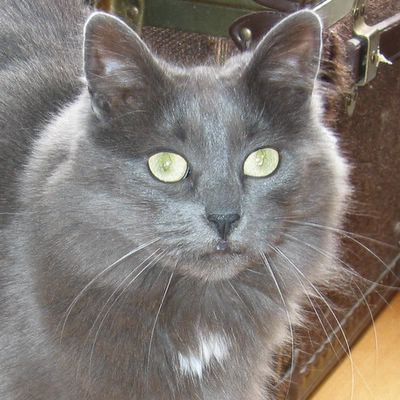Thursday, March 31, 2005
The "right-sized" house: what does that mean?
 "You know you have reached perfection of design not when you have nothing more to add, but when you have nothing more to take away." --Antoine de Saint Exupéry
"You know you have reached perfection of design not when you have nothing more to add, but when you have nothing more to take away." --Antoine de Saint ExupéryThis quotation sets the tone for Jay Shafer's discussion of the philosophy behind his own tiny (100 square foot) house, and the houses that he designs and builds. The smallest of these houses are smaller than the bathrooms found in some new houses, while the largest of Shafer's houses would fit, with room to spare, into the master bedroom of many a suburban McMansion.

 These are the floor plans for the little house shown above, which is the same design as Shafer's own house. This small, self-contained dwelling is 12' x 8', but it contains a bathroom, a kitchenette, a woodstove (which would be quite sufficient to heat a building of its size) and a sleeping loft. Oh, and a little front porch, too... which is an additional 2' long, providing just enough shelter to protect its owner from the elements while unlocking the front door.
These are the floor plans for the little house shown above, which is the same design as Shafer's own house. This small, self-contained dwelling is 12' x 8', but it contains a bathroom, a kitchenette, a woodstove (which would be quite sufficient to heat a building of its size) and a sleeping loft. Oh, and a little front porch, too... which is an additional 2' long, providing just enough shelter to protect its owner from the elements while unlocking the front door. Look carefully at the bottom edge of the photo of this house. See the wheels? As this tiny building is only 8' wide, it fits within a standard traffic lane, and can be hauled behind a truck from one place to another.
Too small, you say? You need a closet? You don't want to climb a ladder to a sleeping loft?
 How about this house? At 12' x 16' and 2 stories, this house has about 320 square feet. While everything in the house is scaled down, it has the essentials: kitchen, built-in eating nook, bathroom, a stair up to the bedroom, a couple of closets. From what I've seen on Shafer's website, the interiors are fitted out rather like those of a yacht, with many built-ins and dual-purpose furniture and spaces. So you won't be able to throw a large dinner party; maybe you can live with that.
How about this house? At 12' x 16' and 2 stories, this house has about 320 square feet. While everything in the house is scaled down, it has the essentials: kitchen, built-in eating nook, bathroom, a stair up to the bedroom, a couple of closets. From what I've seen on Shafer's website, the interiors are fitted out rather like those of a yacht, with many built-ins and dual-purpose furniture and spaces. So you won't be able to throw a large dinner party; maybe you can live with that.
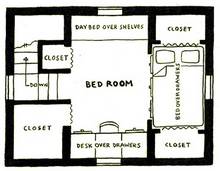
Just to be clear, I don't know that I could live comfortably by myself in a house as small as either of these; certainly Paul and I and los tres gatitos would be bumping more than elbows were we to attempt such a thing. However, a couple of the questions on my mind are just how much space we really do need, and whether we are using fully the space that we do have. While Paul's and my 3-bedroom, 1800-square-foot house is certainly more than 2 adults and 3 cats require, we use most of it regularly. Could we be happy in a smaller house? Probably; it would depend very much on the design the house.
Here are some questions for you: Do you think you could live in this sort of tiny house, either alone or with those others (human or otherwise) with whom you currently live? Have you ever thought that you lived in a place that was too large for either your wants or your needs... or your bank account? What would be the "right-sized" house for you and yours?
Tuesday, March 29, 2005
A special place
 Here in Seattle, construction is just underway on a 19-unit apartment building designed to provide affordable transitional housing for deaf and deaf-blind victims of domestic violence and sexual assault. The Abused Deaf Women's Advocacy Services (ADWAS) broke ground yesterday on A Place of Our Own, the first project of its kind in the country.
Here in Seattle, construction is just underway on a 19-unit apartment building designed to provide affordable transitional housing for deaf and deaf-blind victims of domestic violence and sexual assault. The Abused Deaf Women's Advocacy Services (ADWAS) broke ground yesterday on A Place of Our Own, the first project of its kind in the country. There's a fine article about the project on Businesswire.com. Here are a few excerpts:
"A Place of Our Own" will provide Deaf and Deaf-Blind victims access to those who understand them and know how to help. Deaf women suffer the same rate of abuse as hearing women, but without fully accessible housing alternatives, Deaf and Deaf-Blind victims of abuse must often decide between homelessness and living at home with their abuser. For the first time, "A Place of Our Own" offers a new alternative that helps these women, children and families begin lives free of violence.
Units are scheduled to be available for move-in by spring 2006. The apartments will be open to abused women and their children who earn at or below 30-60 percent of area median income. They will pay no more than 30 percent of their income toward rent.
Architects, landscape architects and interior designers from Mithun collaborated to create "A Place of Our Own." The facility was specially designed to meet the access needs of Deaf and Deaf-Blind residents, staff and volunteers incorporating many special features including: TTY systems; light systems to indicate ringing doorbells and telephones, and fire alarms; appliances embossed with Braille; a specially designed security system; and contrasting paint colors and textures needed for signed communication. The property incorporates sustainable building practices that will help ADWAS save money on energy costs including maximizing the use of natural daylight and using ultra-efficient insulation. The building also includes a multi-purpose room, children and youth rooms, a common laundry facility, computer room, library, a community kitchen for the residents, classroom, a quiet garden, and a secure outdoor children's area. The facility is located on a major transit line, an essential element for its Deaf-Blind residents.
On-site resident services provided by ADWAS will include a 24/7 crisis line; crisis intervention; therapy; legal, medical and systems advocacy; children's program; a positive parenting program; and job search and independent living skills training. ADWAS staff advocates will assist residents in securing any additional services needed, such as food banks and healthcare services and more. Non-residents needing ADWAS' services will also be able to obtain them at "A Place of Our Own."
"A Place of Our Own" is the result of a unique private/public financing arrangement. Approximately $1.6 million of the $7.7 million project is funded through an equity investment from Homestead. The project also is funded by the City of Seattle Office of Housing, Washington State Community Trade and Economic Development Department, the Washington Housing Finance Commission, five King County suburban cities, and the Federal Home Loan Bank Affordable Housing Program sponsored by Sterling Savings Bank.
ADWAS' capital campaign is providing approximately $3.4 million of private funding, including support from: the Sound Families Initiative, the Paul G. Allen Family Foundation, The Ford Foundation and many others. Two challenge grants, $400,000 (the total award is $500,000) from the Bill & Melinda Gates Foundation and $250,000 from The Kresge Foundation, now challenge the community to pledge the remaining $504,000 required to complete the campaign. Key Bank is the construction lender.
If you read that list of funders carefully, you'll see that the project is being built with money from a variety of sources: equity financing from the federal tax-credit program (managed by a non-profit housing investment company), funds provided by city, state and national governmental organizations and programs, grants from several private foundations, and donations from individuals. This is not unusual; this is how a large part of the affordable housing being built today (at least in this part of the country) is financed. It's a complicated process, but one that's working well to provide safe, well-built housing for many people who have gone without for too long.
This is a very special project, one that I'd love to have had a hand in designing. I'll have to satisfy my desire to be a part of making this place a reality by helping with their ongoing capital campaign.
Sunday, March 27, 2005
Carnival of the Cats #53

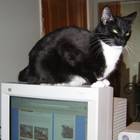

A big, furry welcome from Lyra, Sergei, Sasha and me. This week's edition of the Carnival of the Cats features photos and such from 33 cat-bloggers. By some "luck" of the draw, I seem to be hosting Carnivals following either the ridiculous or the sublime. While I thought about making thumbnails of this week's photos to include in the Carnival, I had only so many hours (too many, according to some members of my household) to devote to this little project. Instead, I'm just using little cartoonish RFOAC's (Reasonable Facsimile Of A Cat, for those wondering in from elsewhere); you'll just have to go to other folks' blogs to see their cats.
First, a memorial post: NYCBabylon writes, "Our dog Maggie passed away this week, so the blog is a little less cat and more dog, but I needed to pay respects to my dog." (Losing a companion - canine, feline or any other sort - is hard; you have my condolences.)
 At Baboon Pirates, El Capitan is engaged in some cat training this week. Apparently Betsy Cat is a very fine trainer.
At Baboon Pirates, El Capitan is engaged in some cat training this week. Apparently Betsy Cat is a very fine trainer.Frightwig at Sundappled Wood brings us Pearl, O'Malley, Ornette and Gusto, mostly in repose.
Josh's Weblog presents The Other Reason We Invented The Web, Part Three. Atticus knows the other reason we invented paper bags.
 Tom at Pooklekufr: the Kafir Constitutionalist presents what he calls Gratuitous Cat Thread I. (Is any cat thread gratuitous? I think not.) Furball Isabella the Third, Bongo the Vicious, Jinx the Schizophrenic, and Babatounde (just plain ol' Babatounde?) all join in.
Tom at Pooklekufr: the Kafir Constitutionalist presents what he calls Gratuitous Cat Thread I. (Is any cat thread gratuitous? I think not.) Furball Isabella the Third, Bongo the Vicious, Jinx the Schizophrenic, and Babatounde (just plain ol' Babatounde?) all join in.Darcey at Dust My Broom has a fine submittal for the infrequently used category of Cat and Frog Blogging. Does Steve have a Friday Ark category for this? Of course he does.
Captain Oates at Little Man, What Now? shows the results of loving like cat and dog. That puppy has some 'splainin' to do.
 Susan at pages turned says, "It's hard not to look down on people when you're living next to the ceiling." Russians rule from lofty ledges.
Susan at pages turned says, "It's hard not to look down on people when you're living next to the ceiling." Russians rule from lofty ledges.From Brainwise at Prophet and Madman: Milo says they're Mine all mine, Otis is on Cloud 9 and the brothers enjoy their Favorite Morning Program.
At Blog d'Elisson, Matata is contemplating a Busy Friday, which includes thinking I can always bite ’Kuna on the ass. Also, Steve poses the question: Why do I get cat hair on my ass every time I sit down on the loveseat in the sunroom? Now He Knows. (Elisson really likes that word "ass," doesn't he?)
 Deb at Sugarfused.net says, "I found some baby pictures last night of my Snowshow Siamese, Sugar, and this one is just too cute not to share." There's also Saturday Elvis blogging.
Deb at Sugarfused.net says, "I found some baby pictures last night of my Snowshow Siamese, Sugar, and this one is just too cute not to share." There's also Saturday Elvis blogging.Lab Kat sends an "Early Years" photo of Pixel napping while Pica stands by.
At Athenamama, Jeff has some old shots of Thalia taking on a very patient Ebby.
 At Running Scared, Jazz's youngest cat Pepe is taking over a sewing project.
At Running Scared, Jazz's youngest cat Pepe is taking over a sewing project.Derek at Blog: Derek Rose has a cat caught in the flash for our perusal.
Diane at DED Space shows us that Velma really knows how to put her foot in her mouth.
 Maggie's Meanderings shows the lovely Maggie posing for her picture.
Maggie's Meanderings shows the lovely Maggie posing for her picture.At Trish Wilson's Blog, Trish says there's "more geeky game cat goodness."
At Curiouser & Curiouser, Michael has a photo of the elegantly handsome Harley sitting in a window.
 At Watermark, Sharon has both the real and the facsimile: Cats & RFOAC's.
At Watermark, Sharon has both the real and the facsimile: Cats & RFOAC's.Barry at Enrevanche shows Mister Gato enjoying some found water.
Ferdinand T. Cat at Conservative Cat respectfully submits that even a superior life form can make an Honest Mistake when hungry.
 Jack at The Peoples' Republic of Seabrook now has scientific proof of things that most of us already know. And there's a photo of the fabulously cute Eric at Jack's place.
Jack at The Peoples' Republic of Seabrook now has scientific proof of things that most of us already know. And there's a photo of the fabulously cute Eric at Jack's place.At Cascade Exposures, Jan tells us, "Seal does yoga while Spectra goes zen" in the Tao of Cat.
Tommy sends photos of Striving For Average's Chocolate Chip trying to decide whether it's dinner time.
 At Lisa Violet's Cathouse, Handsome is settling in.
At Lisa Violet's Cathouse, Handsome is settling in.Russ at Boxing Alcibiades has evidence that a cat can catch more bird than it can chew. Russ says, "why I'm glad I'm more than eight inches tall..."
Martin at EGO writes that, "Due to the Easter fireworks (perhaps this is a Swedish thing?), Morris is an indoor cat today. He managed to stay pretty calm this year."
 Sissy's cats are always trying to help. Baby and Tiny help do the dishes, keep an eye out for feral chickens, and wait to offer assistance whereever required. They also get in on celebrating important dates.
Sissy's cats are always trying to help. Baby and Tiny help do the dishes, keep an eye out for feral chickens, and wait to offer assistance whereever required. They also get in on celebrating important dates.At the Oubliette, the reclusive Mac has come out to watch the party, and Mira catches Eep, Maleficent and McCullough at the new kitty fountain.
Darcy at By the Way writes, "Melvin was being a camera-hog this week. Next week it'll have to be All Lorax."
 At Quite Early One Morning, Zozo has won the coveted Miss Wide Load pageant, and BJ has a pun to gladden an architect's heart.
At Quite Early One Morning, Zozo has won the coveted Miss Wide Load pageant, and BJ has a pun to gladden an architect's heart.Over at CathColl.net, site of next week's Carnival, the lovely Emily demonstrates a new grooming position.
Contributions from last week's Carnival anniversary have Laurence's cats Edloe and Frisky rolling in dough. As Sissy has noted, there's a new TBIFOC feature, Ask the Cats, in which Edloe, Frisky, Piper and Nardo mouth off about politics and comment on pop culture. (Lair says that this feature is political, but I say it's just another excuse for cat blogging, so it's in for this week.)
Late-breaking, from the Mind of Mog: Izzy "is very intelligent, sneaky, fast, really fast especially if there’s food involved. He’s no dim bulb."
 While I have the floor, I want to recommend to y'all the fine Carnival Submittal Form created by Ferdinand T. Cat's human pet, Bruce. Not only it is simple to use, it generates lovely cut-and-paste HTML code for each submittal - a fine starting point for your carnival host or hostess. Thank you, Bruce!
While I have the floor, I want to recommend to y'all the fine Carnival Submittal Form created by Ferdinand T. Cat's human pet, Bruce. Not only it is simple to use, it generates lovely cut-and-paste HTML code for each submittal - a fine starting point for your carnival host or hostess. Thank you, Bruce!Thanks again (and again (and again...)) to Steve at The Modulator for singlehandedly keeping the Friday Ark afloat.
And a very big thank you to Laurence Simon, for the pleasure of hosting this week's Carnival of the Cats. Next week, the Carnival will be at CathColl.net.
Saturday, March 26, 2005
Something that appeals to the human heart

"There is a powerful need for symbolism, and that means the architecture must have something that appeals to the human heart. Nevertheless, the basic forms, spaces, and appearances must be logical. Designs of purely arbitrary nature cannot be expected to last long."
- Kenzo Tange
Kenzo Tange was the most influential Japanese architect in the second half of the 20th century, and was awarded the 9th Pritzker Prize in 1987. The work of modernist architect Le Corbusier had a profound influence on Tange, who spent 4 years early in his career in the office of Kunio Maekawa, a prominent disciple of Le Corbusier. Following WWII, Tange set up his own studio, which became a proving ground for a generation of talented Japanese architects, including Fumihiko Maki, Kisho Kurokawa and Arata Isozaki.
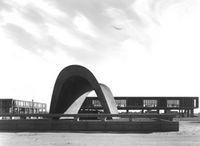 Tange gained international recognition with his first major commission; he was selected as the architect for the master plan for rebuilding Hiroshima after the atomic bomb was dropped on that city in World War II. At the heart of Tange's design was the Hiroshima Peace Center and Peace Memorial, a combination of traditional Japanese Haniwa tomb and a concrete hyperbolic parabola.
Tange gained international recognition with his first major commission; he was selected as the architect for the master plan for rebuilding Hiroshima after the atomic bomb was dropped on that city in World War II. At the heart of Tange's design was the Hiroshima Peace Center and Peace Memorial, a combination of traditional Japanese Haniwa tomb and a concrete hyperbolic parabola.
 Particularly in his earlier work, Tange drew from the forms of traditional Japanese architecture and reinterpreted them using modern materials and construction techniques. The easily-recognizable temple forms shown above can be seen, transformed, in the concrete and suspended high-tension cable roofs of Tange's stadiums for the 1964 Tokyo Olympics. In awarding the Pritzker to Tange, the international jury acknowledged this duality in his work: "His stadiums for the Olympic Games held in Tokyo in 1964 are often described as among the most beautiful structures built in the twentieth century. In preparing a design, Tange arrives at shapes that lift our hearts," the citation said, "because they seem to emerge from some ancient and dimly remembered past and yet are breathtakingly of today."
Particularly in his earlier work, Tange drew from the forms of traditional Japanese architecture and reinterpreted them using modern materials and construction techniques. The easily-recognizable temple forms shown above can be seen, transformed, in the concrete and suspended high-tension cable roofs of Tange's stadiums for the 1964 Tokyo Olympics. In awarding the Pritzker to Tange, the international jury acknowledged this duality in his work: "His stadiums for the Olympic Games held in Tokyo in 1964 are often described as among the most beautiful structures built in the twentieth century. In preparing a design, Tange arrives at shapes that lift our hearts," the citation said, "because they seem to emerge from some ancient and dimly remembered past and yet are breathtakingly of today."In Tange's obituary in the Guardian, Jonathan Glancey wrote:
"The role of tradition," Tange said, "is that of a catalyst which furthers a chemical reaction, but is no longer detectable in the end result. Tradition can, to be sure, participate in a creation, but it can no longer be creative itself."

The Cathedral of St Mary, Tokyo (1964), another powerful meeting of historic and contemporary form and structure, both confirms and denies this article of architectural faith. Tange visited several medieval cathedrals before producing his design. "After experiencing their heaven-aspiring grandeur and ineffably mystical spaces," he said later, "I began to imagine new spaces, and wanted to create them by means of modern technology." Which he did, and yet the soaring concrete cathedral is recognisably medieval in inspiration.
As in all medieval - and many modern - cathedrals, the plan of St. Mary's is cross-shaped, with the main entry at the "foot" of the cross, and the altar at the "head." However, the exposed concrete interior, and the concave, rather than convex, shape of the soaring space within, are anything but traditional.
Kenzo Tange died on March 22. He was 91.
Friday, March 25, 2005
Feline Friday: At the foot of the bed
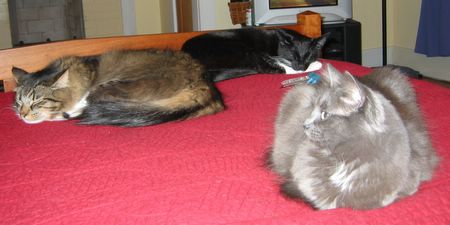
How lucky are we? Our cats like to hang out with us. Many a night finds these three small, furry bodies scattered about on the bed. Sometimes they want to be in direct contact with us; other times they just want to be close.
NOTE: Friday Ark is already going on over at Steve's place. And, this Sunday, the second week of the second year of Carnival of the Cats will be happening here!
Thursday, March 24, 2005
Vision 2020
The Puget Sound Regional Council sponsors an award program called Vision 2020. Here's what they say about them:
I'm going to the awards dinner tonight. Want to know why? Click here.
The Awards recognize inspiring projects, plans, and programs that increase the vitality of the central Puget Sound region and help implement the region's growth, economic, and transportation strategy.
PSRC honors businesses, local governments, and non-profit organizations who do creative work to focus new housing and jobs in urban areas, provide transportation access and mobility, protect our natural environment, and improve the quality of life in the central Puget Sound region.
I'm going to the awards dinner tonight. Want to know why? Click here.
Wednesday, March 23, 2005
New baby
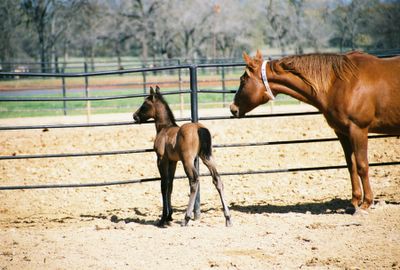
I've mentioned to a couple of friends that I've been feeling I should rename this blog 'Music and Death' or 'Death and Cats' for the week, as there is another architectural master whose passing this week I have yet to mark. And, while I've so far chosen not to write about it here, I've been feeling troubled by the sturm und drang surrounding what I feel should be a personal matter for one family in Florida.
However, this evening I'm taking a break to celebrate a birth. I've never outgrown the love of horses that came upon me when I was five or six. Neither has my sister, and she and her husband have several, including this beautiful baby, who was born on March 5. He was eight days old when she took this photo of him with his mother.
It's Spring. Flowers are blooming all over Seattle. Baby animals are cavorting. It's good to be alive.
Tuesday, March 22, 2005
Like the shaft of an axe

"The job of buildings is to improve human relations: architecture must ease them, not make them worse."
"Architecture, like the shaft of an axe, must beautifully and precisely symbolise its own good reasons for its necessary existence. Insight and sincerity will tell us which reasons are good."
Ralph Erskine
 During a design critique in my second semester of architecture school, my professor suggested that I look at an English housing development known as Byker. It was one of architect Ralph Erskine’s most famous projects, part of a large urban redevelopment in Newcastle-upon-Tyne, England. While my prof made this suggestion because of similarities he saw in the formal (as in relating to form) qualities of my design project and Erskine's design, he unwittingly introduced me to one of the architects whose social conscience and ability to make that conscience manifest in the built environment I have admired since.
During a design critique in my second semester of architecture school, my professor suggested that I look at an English housing development known as Byker. It was one of architect Ralph Erskine’s most famous projects, part of a large urban redevelopment in Newcastle-upon-Tyne, England. While my prof made this suggestion because of similarities he saw in the formal (as in relating to form) qualities of my design project and Erskine's design, he unwittingly introduced me to one of the architects whose social conscience and ability to make that conscience manifest in the built environment I have admired since.Byker is described in Erskine's obituary from the Times Online:
His first work in England to attract widespread attention was the Byker housing near Newcastle, begun in 1960. This was remarkable for the high, protective wall of flats that formed its outward boundary (echoing some of the continuous-wall buildings he had earlier designed for Arctic towns) and for its humane and agreeably relaxed approach to the design of high-density public-authority housing at a time when British work of this kind was being justly criticised for its grim and unsympathetic character.
This "wall" had, however, an important function special to Newcastle: it was created to protect the terraces of flats and houses behind it from the north wind and, no less important, from a ghastly view of asphalt, concrete and cars that would be on Byker’s doorstep should, as planned, the Shields motorway be built. In fact, it never has been, so removing one of the design’s raisons d’être.
Writing at
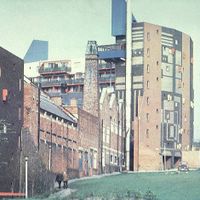
Erskine has had an immense influence on the Scandinavian architectural debate. He has been faithful to his belief in the development of a good and equal society and he has, without compromises, pledged and fought for the need for social and political awareness in the built environment.
He was a true humanist. His buildings radiate optimism, appropriateness and wit, which endear them to many. His philosophy of work accommodated the climate and the context together with the social and humanistic needs of people. He was concerned that the expression of buildings should engage the general public interest, generate a sense of ownership and appeal to genuine participation.
That humanism and generosity of spirit extended also to the worldwide architectural community. With the money from the many prizes and awards that Erskine won, he and his wife created the Ruth and Ralph Erskine Stipend Fund, administered by the Swedish Association of Architects, which every other year presents the $10,000 Ralph Erskine Award to "an individual, group or organization for innovation in architecture and urban design with regard [to] social, ecological and aesthetic aspects. The efforts of the applicant are to have benefitted primarily the less privileged in society."
 Ralph Erskine died on March 16. He was 91. More writing on and images of Erskine's work can be found at his firm's site: Erskine Tovatt Architects. I'll let him have the last words here:
Ralph Erskine died on March 16. He was 91. More writing on and images of Erskine's work can be found at his firm's site: Erskine Tovatt Architects. I'll let him have the last words here:"Architecture and urban planning — be it at macro or micro level, a private villa or an office block — must not only be a showpiece of design and technology, but also give expression to those democratic ideals of respect for human dignity, equality and freedom that are fostered in our society." Amen.
Monday, March 21, 2005
When you drink from the river of silence
To celebrate World Poetry Day, and because Isabella asked about the books of poetry that Helen gave me for my high-school graduation.
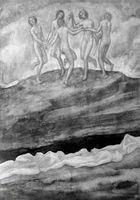 From Kahlil Gibran's Sand and Foam:
From Kahlil Gibran's Sand and Foam:
And from The Prophet:
Many thanks to the Kahlil Gibran Online website, which saved me much time and typing.
 From Kahlil Gibran's Sand and Foam:
From Kahlil Gibran's Sand and Foam:
I am forever walking upon these shores,
Betwixt the sand and the foam,
The high tide will erase my foot-prints,
And the wind will blow away the foam.
But the sea and the shore will remain
Forever.
And from The Prophet:
You would know the secret of death.
But how shall you find it unless you seek it in the heart of life?
The owl whose night-bound eyes are blind unto the day cannot unveil the mystery of light.
If you would indeed behold the spirit of death, open your heart wide unto the body of life.
For life and death are one, even as the river and the sea are one.
In the depth of your hopes and desires lies your silent knowledge of the beyond;
And like seeds dreaming beneath the snow your heart dreams of spring.
Trust the dreams, for in them is hidden the gate to eternity.
Your fear of death is but the trembling of the shepherd when he stands before the king whose hand is to be laid upon him in honour.
Is the shepherd not joyful beneath his trembling, that he shall wear the mark of the king?
Yet is he not more mindful of his trembling?For what is it to die but to stand naked in the wind and to melt into the sun?
And what is to cease breathing, but to free the breath from its restless tides, that it may rise and expand and seek God unencumbered?
Only when you drink from the river of silence shall you indeed sing.
And when you have reached the mountain top, then you shall begin to climb.
And when the earth shall claim your limbs, then shall you truly dance.
Many thanks to the Kahlil Gibran Online website, which saved me much time and typing.
Sunday, March 20, 2005
A sad anniversary
 Last year on this date, my mother's friend Helen was shot to death by a man whom she had never met. It's hard for me to believe that this vibrant, talented, loving woman has been gone for a year. I've been trying to write something about this, to come up with some way of understanding her loss, but I have nothing. I am at a loss. I ache today for her sons, her granddaughter, her other family and her many friends. I miss Helen.
Last year on this date, my mother's friend Helen was shot to death by a man whom she had never met. It's hard for me to believe that this vibrant, talented, loving woman has been gone for a year. I've been trying to write something about this, to come up with some way of understanding her loss, but I have nothing. I am at a loss. I ache today for her sons, her granddaughter, her other family and her many friends. I miss Helen. Since I have nothing new, I'll share something that I wrote a year ago today on Paul vs. the Squamous Monster. That was the day that I realized that writing had become an important part of my life. After Mom called with the news about Helen, I told Paul, and I cried for a long while. Then I said to Paul, "I need to go write." I like to think that this urge to write would've pleased Helen the English professor, the writer, and the inveterate reader.
Random violence, that nasty bastard, wandered into our corner of the universe today, and took one of my mother's closest friends. At about the time that I was writing this morning's post, Helen was shot in broad daylight, at a busy gas station in an upscale Houston neighborhood. My mother called tonight to tell me.
My parents met Helen when they were all students at Rice University. She and her family have been part of my life for as long as I can remember. While she was married to Ben, they were in the monthly 5-couple dinner club that my parents have been part of for almost 40 years. (Ben got the dinner club in the divorce.) We went to family parties at their house. I babysat for their sons, Mark and Neil. (Neil, the younger son, and I share the same birthday, a decade apart.)
Helen was the first of my parents' friends to treat me as if I was becoming an adult. I called her "Helen" when the others were still "Mr." and "Mrs." An inveterate movie buff, she took me to what was probably the first R-rated movie I ever saw, "Coming Home." Seventeen-year-old innocent that I was, I felt uncomfortable watching the sex scene between Jane Fonda and Jon Voigt's characters, especially while sitting next to my mother's friend. If she could tell (and I suspect she could), she never let on. We talked about moviemaking, and acting, and the war.Helen was an artist and professor of literature. Her work, some of which is shown here, was serious and thoughtful. Some of it was dark and rather scary. When I first saw some of the darker pieces, I hadn't learned to appreciate art that was disturbing. I'm better at that now. Still, I like her portraits best, especially the self-portraits and the ones of her companion Charlotte and son Neil.
Helen was one of the friends who came to California to celebrate Paul's and my wedding. She brought her camera, and photographed our family and friends during the weekend. Shortly after the wedding, she presented us with a small photo album, which contains (even given our photographer Joshua's amazing shots) some of my favorite photos from the wedding.
I last saw Helen about a month ago, when Paul and I were in Houston to go to MD Anderson. A cancer survivor herself, she stopped by my parents' house to offer us support, wry humor and hugs. Had I realized it was the last time I would see her, I would've said more to her about, well, about what I'm writing here.
In a recent NPR commentary, a chaplain at a cancer clinic here in Seattle talked about her discussions with oncology nurses regarding their own mortality. She was surprised to find that, if they could choose the way in which they would die, they all would choose cancer... because, they said, modern palliative care is good, and cancer allows time to say goodbye.
God knows that I would not wish cancer on anyone. However, I do wish for the chance that I, my parents, all those who loved her did not have to say goodbye to Helen.
When my sister and I graduated from high school, Helen gave each of us a book of poetry. Melanie's gift from Helen was a volume of Yevgeny Yevtushenko's poetry, a perfect gift from a lover of language to a sensitive young student of Russian. My mother gave a eulogy at Helen's memorial service. In it, she included my words about Helen's first treating me as an adult, and these words from Yevtushenko.
 In any man who dies there dies with him
In any man who dies there dies with himhis first snow and kiss and fight.
It goes with him.
They are left books and bridges
and painted canvas and machinery.
Whose fate is to survive.
But what has gone is also not nothing;
By the rule of the game something has gone.
Not people die but worlds die in them.
Saturday, March 19, 2005
Obsolete
Every once in a while, I find an online quiz that makes me laugh out loud. Today, What obsolete skill are you? at Quizilla did the trick.
I am admittedly fond of things that are obsolete, anachronistic, or at least unusual in our modern urban world. I make my own music. One type of dancing that I do is mentioned in Shakespeare's writing. I do a lot of canning, and have been planning to plant our yard in edible plants. Perhaps you do one or all of these things as well; I'm just saying that we're not in the majority around here.
I know many people who have unusual - perhaps even obsolete - talents and skills; that is part of what makes them interesting. Do you have any anachronistic pastimes? And, if you're willing to share, what obsolete skill are you?
Oh, and what obsolete skill am I?
 You are 'Latin'. Even among obsolete skills, the tongue of the ancient Romans is a real anachronism. With its profusion of different cases and conjugations, Latin is more than a language; it is a whole different way of thinking about things.
You are 'Latin'. Even among obsolete skills, the tongue of the ancient Romans is a real anachronism. With its profusion of different cases and conjugations, Latin is more than a language; it is a whole different way of thinking about things.
You are very classy, meaning that you value the classics. You value old things, good things which have stood the test of time. You value things which have been proven worthy and valuable, even if no one else these days sees them that way. Your life is touched by a certain 'pietas', or piety; perhaps you are even a Stoic. Nonetheless, you have a certain fascination with the grotesque and the profane. Also, the modern world rejects you like a bad transplant.
Your problem is that Latin has been obsolete for a long time.
Indeed. Ah, would that that were my only problem...
I am admittedly fond of things that are obsolete, anachronistic, or at least unusual in our modern urban world. I make my own music. One type of dancing that I do is mentioned in Shakespeare's writing. I do a lot of canning, and have been planning to plant our yard in edible plants. Perhaps you do one or all of these things as well; I'm just saying that we're not in the majority around here.
I know many people who have unusual - perhaps even obsolete - talents and skills; that is part of what makes them interesting. Do you have any anachronistic pastimes? And, if you're willing to share, what obsolete skill are you?
Oh, and what obsolete skill am I?
 You are 'Latin'. Even among obsolete skills, the tongue of the ancient Romans is a real anachronism. With its profusion of different cases and conjugations, Latin is more than a language; it is a whole different way of thinking about things.
You are 'Latin'. Even among obsolete skills, the tongue of the ancient Romans is a real anachronism. With its profusion of different cases and conjugations, Latin is more than a language; it is a whole different way of thinking about things.You are very classy, meaning that you value the classics. You value old things, good things which have stood the test of time. You value things which have been proven worthy and valuable, even if no one else these days sees them that way. Your life is touched by a certain 'pietas', or piety; perhaps you are even a Stoic. Nonetheless, you have a certain fascination with the grotesque and the profane. Also, the modern world rejects you like a bad transplant.
Your problem is that Latin has been obsolete for a long time.
Indeed. Ah, would that that were my only problem...
Friday, March 18, 2005
Feline Friday: Lyra
Lyra has been left out of the Friday catblogging for a couple of weeks, so today it's all about her. This is, after all, how she believes life should be.

More Lyra ->
Carnival of the Cats' First Anniversary Edition is up at the home of its founder. I'll be hosting the Carnival here next week.

More Lyra ->
Carnival of the Cats' First Anniversary Edition is up at the home of its founder. I'll be hosting the Carnival here next week.
Thursday, March 17, 2005
Not just skyscrapers and suburbs
While my hometown of Houston may be best known architecturally for its world-class skyscrapers and miles of sprawling suburbs, there are, tucked away in some of its oldest neighborhoods, works of personal architecture that rival any skyscraper for creativity and make a mockery of the banal blandness of the modern suburban house.
 Some people might take a NIMBYish attitude to these idiosyncratic artistic expressions, but in Texas, where the rights of the property owner are paramount, and particularly in Houston, the land that zoning forgot, there's not much a neighbor could do to stop the homeowner who's so inclined from, let's say, covering his entire house in beer cans. And that is just what Houstonian John Milkovisch did to this modest little bungalow in Houston's West End.
Some people might take a NIMBYish attitude to these idiosyncratic artistic expressions, but in Texas, where the rights of the property owner are paramount, and particularly in Houston, the land that zoning forgot, there's not much a neighbor could do to stop the homeowner who's so inclined from, let's say, covering his entire house in beer cans. And that is just what Houstonian John Milkovisch did to this modest little bungalow in Houston's West End.
The Orange Show Center for Visionary Art's history of the Beer Can House describes the evolution of Milkovisch's house:
The result was quirky and dazzling. Milkovisch lived in and continued to tinker with his house until his death in 1988. He apparently enjoyed people's reactions to the place, saying, "It tickles me to watch people screech to a halt. They get embarrassed. Sometimes they drive around the block a couple of times. Later they come back with a carload of friends." His wife Mary continued to live in the house for years after his death; the house was sold to the Orange Show Foundation, predecessor of the Orange Show Center for Visionary Art, shortly before her death in 2002.
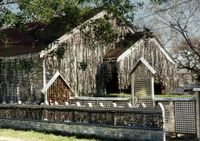

In an article today, the Houston Chronicle announced that the Houston Endowment has given a $125,000 grant to help in restoration of the Beer Can House.
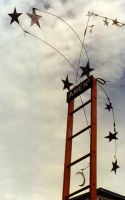
The Beer Can House. The Orange Show. The Art Car Festival. The Artery. All these quirky, idiosyncratic, personal works of livable, drivable and performance art make Houston a much more interesting place than it otherwise would be. Long may they stand.
 Some people might take a NIMBYish attitude to these idiosyncratic artistic expressions, but in Texas, where the rights of the property owner are paramount, and particularly in Houston, the land that zoning forgot, there's not much a neighbor could do to stop the homeowner who's so inclined from, let's say, covering his entire house in beer cans. And that is just what Houstonian John Milkovisch did to this modest little bungalow in Houston's West End.
Some people might take a NIMBYish attitude to these idiosyncratic artistic expressions, but in Texas, where the rights of the property owner are paramount, and particularly in Houston, the land that zoning forgot, there's not much a neighbor could do to stop the homeowner who's so inclined from, let's say, covering his entire house in beer cans. And that is just what Houstonian John Milkovisch did to this modest little bungalow in Houston's West End.The Orange Show Center for Visionary Art's history of the Beer Can House describes the evolution of Milkovisch's house:
In the late 60's John's interest was shifting away from upholstery and toward creating what's now referred to as the "Beer Can House" at 222 Malone St. John started his project in 1968 inlaying thousands of marbles, rocks, brass figures and metal pieces in concrete blocks and redwood, all of which were used to make patios, fences, flower boxes, etc. The result was a yard with no grass. The entire front and back was covered with cement. When asked why he did it, John simply answered, "I got sick of mowing the grass." After the yard was completely covered, he shifted his attention to the aluminum can. He used various parts of aluminum cans (tops, bottoms, sides, and tabs) to make curtains, mobiles, fences, sculptures, windmills, and wind chimes. He wired the bottoms into long chains and dangled them from the eaves. Along the sides of the house, he alternated strands of pull-tabs, bottoms, and flat screens made from the labels. In other places, he made the tops of the cans spin inside an outer ring of narrow metal and looped them through the trees in the backyard.
The result was quirky and dazzling. Milkovisch lived in and continued to tinker with his house until his death in 1988. He apparently enjoyed people's reactions to the place, saying, "It tickles me to watch people screech to a halt. They get embarrassed. Sometimes they drive around the block a couple of times. Later they come back with a carload of friends." His wife Mary continued to live in the house for years after his death; the house was sold to the Orange Show Foundation, predecessor of the Orange Show Center for Visionary Art, shortly before her death in 2002.


In an article today, the Houston Chronicle announced that the Houston Endowment has given a $125,000 grant to help in restoration of the Beer Can House.
Efforts to restore Milkovisch's Beer Can House, which has suffered years of gradual decline, have moved into high gear with a $125,000 Houston Endowment grant to the Orange Show Center for Visionary Art, which acquired the house in November 2001. "The Beer Can House represents the sort of idiosyncratic individualism that Houstonians and Texans pride themselves on," Emily Todd, the endowment's grant officer, said Wednesday.
Orange Show Executive Director Susanne Theis said repair and restoration of the house at 222 Malone west of downtown should be complete by late next year. The house then will be open for tours.
The house's evolution
Theis said Orange Show staff is searching for an architect to trace the house's artistic evolution the first step in restoration. Once it is determined which version of the house represented its artistic peak, restorers will begin cleaning or replacing the damaged components.
"Some things have just been lost over time," Theis said, noting that in his lifetime Milkovisch made numerous changes as various elements of his creation were damaged by storms. Among features no longer present are a graceful arch of beer-can tops and bottoms across the driveway and a curtain of pop tops that once shaded the building's south side.
Additionally, steel portions of the structure have rusted, aluminum parts have oxidized, and parts of the residence's concrete-covered yard, studded with thousands of marbles, have crumbled. Theis said tests of soil and concrete will be scheduled to determine the overall stability of the site. The house generally is in good repair, she said.
Reproducing old cans
Much of the restoration will be performed by volunteers, although final installation of components likely will be handled by professional carpenters. In some cases, Theis said, brewers might be asked to reproduce the discontinued cans Milkovisch used in his project. Already, can collectors have donated vintage cans to the effort.
Changes in the neighborhood also have contributed to the site's degradation, Theis said. Once a working-class enclave of single-family homes, the neighborhood in recent years has experienced rampant redevelopment. The Beer Can House now is flanked by multistory townhomes, one of which was erected about three feet from the property line.
With new development blocking sunlight, a once-sparkling fence studded with colored glass marbles has gone dull. Theis said plans call for installation of lighting to again illuminate the fence. Plans also call for a vine-covered trellis at the building's rear to suggest the greenery of trees that have been removed as adjoining property was developed.

The Beer Can House. The Orange Show. The Art Car Festival. The Artery. All these quirky, idiosyncratic, personal works of livable, drivable and performance art make Houston a much more interesting place than it otherwise would be. Long may they stand.
Tuesday, March 15, 2005
An interview in five questions
I have finally finished answering five interview questions from Badaunt of Present Simple. Those with photographic memories will note that one of these is not a question that Badaunt asked of me. It is, however, an interview question that she asked of another blogger.
As she wrote, "the rules go that the first five people to comment will be interviewed by me... If I could do it, so can you." And so can you, too. I promise I'll be gentle.
1. Which of your cats is most like you, and why?
Lyra is most like me, or perhaps I should say that I am most like her. We share some obvious characteristics: we are female, smaller and rounder than many of our kind, and gray. (My gray is perhaps more like Sasha’s multicolored tabby fur than Lyra’s consistently colored coat, but Lyra and I both have silver linings in the right light.)
We like people immensely, are very affectionate and vocal, and are also rather shy and afraid of being badly treated.
2. Somebody said something to you once that you think is absolutely not true... but sometimes you wonder. What was it?
My violin teacher, Mr. Hess, used to say that every day that one (meaning, of course, me) does not practice, one loses half of her (me again) technique. He was not talking about the mechanics of playing, but about that facility - control, fluidity, speed - that comes with everyday practice. While I understood that regular practice was important, I did not believe that a day off would result in such a great loss.
I am living proof that, if one leaves the violin in the closet for, let's say, a decade, even one's feel for the mechanics of playing will eventually atrophy... I am thankful that the knack came back more easily than when first acquired. Although I know that I'm now a much more sophisticated musician than when I was studying with Mr. Hess, I do not have the technique that I had at 18, when I played almost every day. At this point, I use my musicianship to cover for flaws in technique... and wish that I had time to play every day.
3. Who is someone from your past you'd really like to meet again, and why?
Someone I'd really like to meet again is Grandaddy Reed, my maternal grandfather. He was 20 years older than my grandmother, and died when I was 5. Although I have few memories of him that aren't related to photos, I understand that he and I adored each other, and that I mourned his death, in my childlike way, long after he died. He is the only one of my grandparents who did not live to see me grow up, the only one with whom I was never able to discuss his/her life.
Grandaddy Reed was born just before the turn of the last century into a family that owned a ranch and ran a trading post, known as Ultima Thule, at what is now the southern Arkansas-Oklahoma border. At that time, it was the last place in 'civilization' to buy supplies before heading into Indian Territory. I would love to know about his childhood in that time and place. He drove an ambulance in France during WWI; I imagine that, were I to somehow be able to meet him now, he still would not want to talk about that. I would like to hear his stories about his life with my grandmother, my mother and my aunt. I would like to hear his stories about his relationship with the little girl whose pajamas were embroidered 'Grandpa Loves Me'.
4. What was your biggest fashion mistake?
Thick, pale blue legwarmers, over jeans, with heels, on a 5'-1" frame. *shudder* That's all I can bring myself to say.
5. What's the last thing that made you laugh unexpectedly and loudly and without restraint?
I liked this question at Tiny Hands so much that I had to answer it... and then I couldn't remember what exactly the answer would be. It was this past weekend, as there was much surprised laughter during our band rehearsals and the socializing that followed.
I do remember the last time that I saw Paul laugh in this way. This past Sunday, he was writing on his computer in the room next to where the band was rehearsing. The tune we were playing, called 'Nonesuch, or, A la mode de France,' is a well-known English country dance tune from the 1600s. It has an early music feel, and we were playing it in as proper a fashion as we could manage on two violins, muted French horn and piano. After a few times through the tune, all of us switched instruments... and began playing the tune, in a very period-appropriate four part harmony... on kazoos. Paul just about fell out of his chair, he was laughing so hard. This made me lose it on my kazoo. (I will have to practice more before the dance, as I'm sure there will be laughter there as well.)
These are not the only '5 questions' interview answers on this blog. Because Melinama decided that posting her answers at her place was against her blog policy, she tucked them into the comments on one of my posts, here.
Badaunt's other interviewees have answered their questions, too: Mel of Actual Unretouched Photo, Tiny Hands of as told to (your name here), and TorryGirl.
As she wrote, "the rules go that the first five people to comment will be interviewed by me... If I could do it, so can you." And so can you, too. I promise I'll be gentle.
1. Which of your cats is most like you, and why?
Lyra is most like me, or perhaps I should say that I am most like her. We share some obvious characteristics: we are female, smaller and rounder than many of our kind, and gray. (My gray is perhaps more like Sasha’s multicolored tabby fur than Lyra’s consistently colored coat, but Lyra and I both have silver linings in the right light.)
We like people immensely, are very affectionate and vocal, and are also rather shy and afraid of being badly treated.
2. Somebody said something to you once that you think is absolutely not true... but sometimes you wonder. What was it?
My violin teacher, Mr. Hess, used to say that every day that one (meaning, of course, me) does not practice, one loses half of her (me again) technique. He was not talking about the mechanics of playing, but about that facility - control, fluidity, speed - that comes with everyday practice. While I understood that regular practice was important, I did not believe that a day off would result in such a great loss.
I am living proof that, if one leaves the violin in the closet for, let's say, a decade, even one's feel for the mechanics of playing will eventually atrophy... I am thankful that the knack came back more easily than when first acquired. Although I know that I'm now a much more sophisticated musician than when I was studying with Mr. Hess, I do not have the technique that I had at 18, when I played almost every day. At this point, I use my musicianship to cover for flaws in technique... and wish that I had time to play every day.
3. Who is someone from your past you'd really like to meet again, and why?
Someone I'd really like to meet again is Grandaddy Reed, my maternal grandfather. He was 20 years older than my grandmother, and died when I was 5. Although I have few memories of him that aren't related to photos, I understand that he and I adored each other, and that I mourned his death, in my childlike way, long after he died. He is the only one of my grandparents who did not live to see me grow up, the only one with whom I was never able to discuss his/her life.
Grandaddy Reed was born just before the turn of the last century into a family that owned a ranch and ran a trading post, known as Ultima Thule, at what is now the southern Arkansas-Oklahoma border. At that time, it was the last place in 'civilization' to buy supplies before heading into Indian Territory. I would love to know about his childhood in that time and place. He drove an ambulance in France during WWI; I imagine that, were I to somehow be able to meet him now, he still would not want to talk about that. I would like to hear his stories about his life with my grandmother, my mother and my aunt. I would like to hear his stories about his relationship with the little girl whose pajamas were embroidered 'Grandpa Loves Me'.
4. What was your biggest fashion mistake?
Thick, pale blue legwarmers, over jeans, with heels, on a 5'-1" frame. *shudder* That's all I can bring myself to say.
5. What's the last thing that made you laugh unexpectedly and loudly and without restraint?
I liked this question at Tiny Hands so much that I had to answer it... and then I couldn't remember what exactly the answer would be. It was this past weekend, as there was much surprised laughter during our band rehearsals and the socializing that followed.
I do remember the last time that I saw Paul laugh in this way. This past Sunday, he was writing on his computer in the room next to where the band was rehearsing. The tune we were playing, called 'Nonesuch, or, A la mode de France,' is a well-known English country dance tune from the 1600s. It has an early music feel, and we were playing it in as proper a fashion as we could manage on two violins, muted French horn and piano. After a few times through the tune, all of us switched instruments... and began playing the tune, in a very period-appropriate four part harmony... on kazoos. Paul just about fell out of his chair, he was laughing so hard. This made me lose it on my kazoo. (I will have to practice more before the dance, as I'm sure there will be laughter there as well.)
These are not the only '5 questions' interview answers on this blog. Because Melinama decided that posting her answers at her place was against her blog policy, she tucked them into the comments on one of my posts, here.
Badaunt's other interviewees have answered their questions, too: Mel of Actual Unretouched Photo, Tiny Hands of as told to (your name here), and TorryGirl.
Sunday, March 13, 2005
On becoming a band
This weekend, I'm in the Bay Area. The odd weather patterns on the west coast are continuing; it has been cloudy here, while Seattle is having one of those sunny, warm(er) weekends that makes a lie of the "rains all the time" story.
Yesterday, I spent the afternoon at a band rehearsal for a big dance in April. For this event, I am the 'guest musician' with a 3-person band that plays together regularly in the Bay Area. I have played with two of the three musicians before, and know something of their styles. However, every configuration of musicians is a new experience. With each new grouping, the musicians involved must discover how to 'tune' their playing in such a way that they sound like an ensemble, rather then a motley - if accomplished - crew of players. While musicians sometimes joke that the definition of a band is "musicians who start together and stop together" (which is sometimes not as simple as it sounds), there's so much more that makes for a good band. Really listening to one another is obviously critical. But listening well is insufficient; responding to what the other musicians "say" with their instruments - making the music a conversation rather than several people talking at each other - that is the trick.
The doorbell just rang. It's time for another several hours of rehearsal: lots of playing, listening, and exploring. We'll sound like a band by the time we're done today. And once we've done that, we'll have to keep it up; being a band is, after all, a process... just like any relationship.
Yesterday, I spent the afternoon at a band rehearsal for a big dance in April. For this event, I am the 'guest musician' with a 3-person band that plays together regularly in the Bay Area. I have played with two of the three musicians before, and know something of their styles. However, every configuration of musicians is a new experience. With each new grouping, the musicians involved must discover how to 'tune' their playing in such a way that they sound like an ensemble, rather then a motley - if accomplished - crew of players. While musicians sometimes joke that the definition of a band is "musicians who start together and stop together" (which is sometimes not as simple as it sounds), there's so much more that makes for a good band. Really listening to one another is obviously critical. But listening well is insufficient; responding to what the other musicians "say" with their instruments - making the music a conversation rather than several people talking at each other - that is the trick.
The doorbell just rang. It's time for another several hours of rehearsal: lots of playing, listening, and exploring. We'll sound like a band by the time we're done today. And once we've done that, we'll have to keep it up; being a band is, after all, a process... just like any relationship.
Friday, March 11, 2005
Feline Friday: They're watching you
Feline eyes...
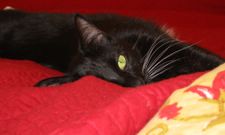

I know that, since I talked him into getting three cats, Paul has been worrying about me. Now I have proof that he need not worry!
Whatever do you mean? ->


I know that, since I talked him into getting three cats, Paul has been worrying about me. Now I have proof that he need not worry!
Whatever do you mean? ->


 Music and Cats
Music and Cats

